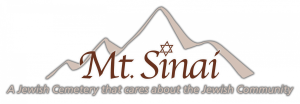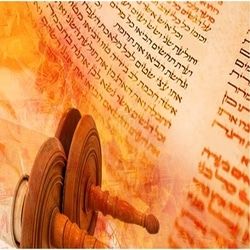
Customs & Traditions
“For dust thou art, and unto dust shall thou return.”–Genesis 3:19
This section is a general guide to Jewish customs and traditions regarding funerals, mourning rituals, and associated practices.
Part of the greatness of Judaism is the fact that it affords us concrete ways of working through our grief. It allows us to demonstrate our respect and affection for those now departed, whose lives touched ours with love and caring. Most often, as we act on those mitzvot (good deeds), we ease our pain and sadness as well.
This section is by no means exhaustive. Should you wish to delve further into the customs and ceremonies described herein, please consult your Rabbi.
Mt. Sinai honors the traditions and the wishes of families from all branches of Judaism. If a family chooses to follow the more traditional Jewish practices, the funeral home arranges for a Shomer (watcher) to sit with the body continuously until the funeral and recite from the Book of Psalms. The body is washed in a process of Taharah (“purification”), considered a sacred and religious act, and then dressed in a burial shroud of white linen cloth. The body is then placed in a wooden casket.
In Jewish tradition, we pray facing east, towards Jerusalem. Funeral services, arranged by the mortuary, can be held in the beautiful covered outdoor Pavilion at Mt. Sinai, facing East to the beauty and splendor of the mountains and desert surroundings. The Pavilion is equipped with a sound system, ceiling fans, and a misting system. Following the service, the casket is moved to the gravesite, often by pallbearers. The walkways to every grave at Mt. Sinai allow this to take place easily and assure that no one will walk or step upon a grave.
After lowering the casket into the grave, it is traditional for the mourners and friends to complete the burial by each placing a few shovels of dirt onto the casket. This act is considered the ultimate Mitzvah (“commandment” or “good deed”) because the deceased cannot do it for himself, cannot ask the mourners to do it for him, and cannot repay or thank them for seeing to his proper Jewish burial. This is the final Mitzvah the mourners and friends are able to perform on behalf of the deceased. The Kaddish prayer is then recited.
Originating out of a superstition in the early post-Talmudic period, the ritual of washing one’s hands after being at the cemetery was done to dispel the evil demons that might have attached themselves there. Another explanation is to cleanse oneself of the ritual impurity of being in contact with the dead in any way. For the convenience of mourners and visitors, several hand-washing stations are placed throughout Mt. Sinai.
The ancient custom of placing a headstone over the burial site originates in the Torah, when Jacob placed a pillar on his wife Rachel’s grave. The headstone serves to clearly indicate the resting place of the deceased, and is a permanent and tangible memorial.The unveiling is a beautiful graveside ceremony marking the setting of a loved one’s headstone. Gathering to unveil the monument serves as an important part of the mourning and healing process. The unveiling of the monument can take place anytime from the end of Shloshim (the 30 days after the funeral) to the first Yahrzeit (anniversary date). The ceremony, often led by a rabbi, is brief and usually informal.
In biblical times, graves were marked by a pile of stones. Today scholars suggest that the custom of leaving a pebble on the monument serves as a visible sign that the deceased is loved and remembered. At the unveiling, those present can mark the occasion by placing a small stone on the memorial.
Yahrzeit is a Yiddish word meaning “a year’s time”. Each year the anniversary of the death of a loved one is commemorated according to the date of death in the Hebrew calendar.
It is customary to commemorate a Yahrzeit by attending services and reciting the Kaddish prayer, lighting a Yahrzeit candle on the evening prior to the date, and giving Tzedakah (charity), in memory of the deceased.
The Yahrzeit date is dependent on both the day and time of death. If the time of death was after sundown, use the next day’s date to determine the appropriate Yahrzeit date.
Kaddish, or “holy” in Yiddish, is known as the mourner’s prayer. The prayer does not speak of death or mourning, but is an affirmation of life and our unfailing faith in G-d. By reciting it, the mourners show that even as their faith is being tested by their loss, they are affirming the greatness of G-d.
The Mourner’s Kaddish is traditionally recited for parents, spouses, siblings and children. It is recited for eleven months following burial for parents and for thirty days for all other relatives.
We say the Mourner’s Kaddish each year on the anniversary of death, known as Yahrzeit. By reciting the Mourner’s Kaddish, we preserve the memory of our beloved, even after the formal period of mourning has ended. We also recite the Mourner’s Kaddish at memorial services known as Yizkor, meaning “remembrance”. Yizkor occurs four times a year: Yom Kippur, the eighth day of Sukkot known as Shemini Atzeret, the last day of Passover and the second day of Shavuot.
We light the Shabbat candles on Friday at sunset and recite the blessing to reaffirm the faith that has sustained our people throughout history. We also light candles on the eve of Rosh Hashanah, Yom Kippur, first and last 2 days of Pesach (Passover) and 2nd day of Shavuot.
*Cemetery Office and Gates Closed
Holidays and Yizkor Dates Commence the Prior Evening*
*Rosh Hashanah – Sept. 23 – Sept. 24, 2025
*Yom Kippur – Oct. 2, 2025*
*Sukkot – Oct. 7* – Oct. 8, 2025
*Shemini Atzeret – Oct. 14, 2025*
*Simchat Torah – Oct. 15, 2025*
Chanukkah (1st Candle) – Dec. 14, 2025
Tu B’Shvat – Feb. 2, 2026*
Purim – Mar. 3, 2026*
*Passover (1st, 2nd, 7th, and 8th days) – Apr. 2*, 3, 8, 9, 2026
Yom HaShoah – Apr. 14, 2026*
Yom Hazikaron – Apr. 21, 2026*
Yom Ha’Atzmaut – April 22, 2026*
Lag B’Omer – May 5, 2026*
*Shavuot – May 22*- 23, 2026
Tisha B’Av – Jul. 9 , 2026*
